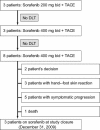Continuous administration of sorafenib in combination with transarterial chemoembolization in patients with hepatocellular carcinoma: results of a phase I study
- PMID: 21036880
- PMCID: PMC3227910
- DOI: 10.1634/theoncologist.2010-0180
Continuous administration of sorafenib in combination with transarterial chemoembolization in patients with hepatocellular carcinoma: results of a phase I study
Abstract
Background and aim: It is unknown whether sorafenib can be combined with transarterial chemoembolization (TACE) in patients with hepatocellular carcinoma. This study assesses the safety and tolerability of a continuous regimen of sorafenib combined with TACE.
Methods: This was an open-label phase I study testing a continuous administration of sorafenib (dose escalation from 200 mg twice daily [bid] to 400 mg bid) starting 7 days prior to TACE with doxorubicin (50 mg).
Results: Twenty-one patients were screened and 14 received sorafenib combined with TACE. Because there were no dose-limiting toxicities in the first three patients who received sorafenib at a dose of 200 mg bid, subsequent patients received 400 mg bid. Twenty-seven procedures were performed (median, two per patient) and two local therapy-related severe adverse events occurred. The median duration of sorafenib therapy was 246 days (range, 14-547 days). Sorafenib-related adverse events of grade ≥3 were hand-foot skin reaction (n = 3), weight loss (n = 2), diarrhea (n = 1), abdominal pain (n = 1), and thrombocytopenia (n = 3). After treatment with sorafenib and TACE, there was a significant decrease in the concentration of plasma vascular endothelial growth factor (VEGF) from 93 ng/l to 67 ng/l.
Conclusions: Continuous administration of sorafenib at a dose of 400 mg bid combined with TACE was tolerable. The adverse event profile of this regimen was comparable with that of sorafenib monotherapy with the exception of thrombocytopenia, which may be more frequent. There were no increases in the circulating VEGF levels after TACE with this combined regimen. (Swiss Association for the Study of the Liver study number 25; ClinicalTrials.gov trial identifier, NCT00478374).
Conflict of interest statement
The content of this article has been reviewed by independent peer reviewers to ensure that it is balanced, objective, and free from commercial bias. No financial relationships relevant to the content of this article have been disclosed by the independent peer reviewers.
Figures


Similar articles
-
Conventional transarterial chemoembolisation in combination with sorafenib for patients with hepatocellular carcinoma: a pilot study.Eur Radiol. 2012 Jun;22(6):1214-23. doi: 10.1007/s00330-011-2368-z. Epub 2012 Jan 4. Eur Radiol. 2012. PMID: 22215073 Clinical Trial.
-
Sorafenib: a review of its use in advanced hepatocellular carcinoma.Drugs. 2009;69(2):223-40. doi: 10.2165/00003495-200969020-00006. Drugs. 2009. PMID: 19228077 Review.
-
Phase II trial of sorafenib combined with concurrent transarterial chemoembolization with drug-eluting beads for hepatocellular carcinoma.J Clin Oncol. 2011 Oct 20;29(30):3960-7. doi: 10.1200/JCO.2011.37.1021. Epub 2011 Sep 12. J Clin Oncol. 2011. PMID: 21911714 Free PMC article. Clinical Trial.
-
Prospective, randomized, double-blind, multi-center, Phase III clinical study on transarterial chemoembolization (TACE) combined with Sorafenib versus TACE plus placebo in patients with hepatocellular cancer before liver transplantation - HeiLivCa [ISRCTN24081794].BMC Cancer. 2008 Nov 26;8:349. doi: 10.1186/1471-2407-8-349. BMC Cancer. 2008. PMID: 19036146 Free PMC article. Clinical Trial.
-
Sorafenib: in hepatocellular carcinoma.Drugs. 2008;68(2):251-8. doi: 10.2165/00003495-200868020-00007. Drugs. 2008. PMID: 18197728 Review.
Cited by
-
Dynamic Nomogram for Predicting Macrovascular Invasion of Patients with Unresectable Hepatocellular Carcinoma after Transarterial Chemoembolization.J Cancer. 2022 Mar 28;13(6):1914-1922. doi: 10.7150/jca.69548. eCollection 2022. J Cancer. 2022. PMID: 35399712 Free PMC article.
-
Management of hepatocellular carcinoma: beyond sorafenib.Curr Oncol Rep. 2012 Jun;14(3):257-66. doi: 10.1007/s11912-012-0233-0. Curr Oncol Rep. 2012. PMID: 22434314 Review.
-
Prognosis Nomogram for Hepatocellular Carcinoma Patients with Portal Vein Invasion Undergoing Transarterial Chemoembolization Plus Sorafenib Treatment: A Retrospective Multicentre Study.Cardiovasc Intervent Radiol. 2021 Jan;44(1):63-72. doi: 10.1007/s00270-020-02579-2. Epub 2020 Sep 23. Cardiovasc Intervent Radiol. 2021. PMID: 32965582
-
Efficacy evaluation of the combination therapy of sorafenib and transarterial chemoembolization for unresectable HCC: a systematic review and meta-analysis of comparative studies.Ann Transl Med. 2020 Apr;8(8):540. doi: 10.21037/atm.2020.02.115. Ann Transl Med. 2020. PMID: 32411763 Free PMC article.
-
Potentiality and boundaries of use of sorafenib in patients with hepatocellular carcinoma: awaiting the results of ongoing clinical trials.Cancers (Basel). 2012 Jun 5;4(2):549-65. doi: 10.3390/cancers4020549. Cancers (Basel). 2012. PMID: 24213324 Free PMC article.
References
-
- Parkin DM, Bray F, Ferlay J, et al. Global cancer statistics, 2002. CA Cancer J Clin. 2005;55:74–108. - PubMed
-
- Llovet JM, Di Bisceglie AM, Bruix J, et al. Design and endpoints of clinical trials in hepatocellular carcinoma. J Natl Cancer Inst. 2008;100:698–711. - PubMed
-
- Camma C, Schepis F, Orlando A, et al. Transarterial chemoembolization for unresectable hepatocellular carcinoma: Meta-analysis of randomized controlled trials. Radiology. 2002;224:47–54. - PubMed
-
- Llovet JM, Bruix J. Systematic review of randomized trials for unresectable hepatocellular carcinoma: Chemoembolization improves survival. Hepatology. 2003;37:429–442. - PubMed
-
- Li X, Feng GS, Zheng CS, et al. Influence of transarterial chemoembolization on angiogenesis and expression of vascular endothelial growth factor and basic fibroblast growth factor in rat with Walker-256 transplanted hepatoma: An experimental study. World J Gastroenterol. 2003;9:2445–2449. - PMC - PubMed
Publication types
MeSH terms
Substances
Associated data
LinkOut - more resources
Full Text Sources
Medical
Research Materials
Miscellaneous

